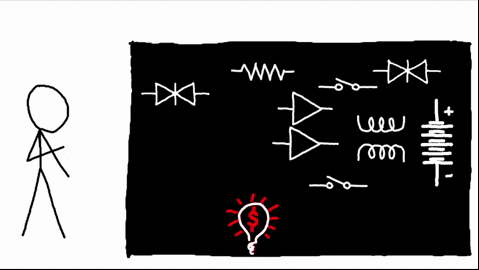Gatekeepers? No Problem! 3 Knock-Out Methods to Reach Your Decision Maker
To succeed as a consultant, you have to electrocute yourself. Okay, that may not be exactly correct… though I did fool around with the insides of an electric radio when I was a kid and gave myself one heck of a shock. Correction: To succeed as a consultant, you have to attach yourself to a particular power source— the decision maker at the client. More importantly, you have to connect to that power source even when all sorts of inconvenient people clog the way. I’ll show you how.
Consultants often talk about gatekeepers. There is actually a panoply of characters who can shut down your prospective project. Let’s cover them quickly using the power/circuit metaphor.
![]() Decision Maker – This is your power source. S/he’s the only person who can say, “Yes” and inject the juice (a.k.a. money) necessary to get your project running.
Decision Maker – This is your power source. S/he’s the only person who can say, “Yes” and inject the juice (a.k.a. money) necessary to get your project running.
![]() Gatekeepers – Can’t say “No” to a project, but can prevent you from reaching the decision maker.
Gatekeepers – Can’t say “No” to a project, but can prevent you from reaching the decision maker.
![]() Breakers – Only can say “No” or “Okay.” In other words, they have the veto power to bust your circuit, but they can’t light it up.
Breakers – Only can say “No” or “Okay.” In other words, they have the veto power to bust your circuit, but they can’t light it up.
Resistors – Anyone at any level who is resistant to you![]() r project. They can’t outright veto it, but they have influence and make your prospects dimmer.
r project. They can’t outright veto it, but they have influence and make your prospects dimmer.
![]() Amplifiers – Your champion(s) inside the organization. They can boost your power insight the organization and brighten your future. Ironically, a resistor you convert to your cause will often become your loudest amplifier.
Amplifiers – Your champion(s) inside the organization. They can boost your power insight the organization and brighten your future. Ironically, a resistor you convert to your cause will often become your loudest amplifier.
 Transformers – Have little influence on whether or not you win a project, but can significantly impact the scope, terms or other parameters.
Transformers – Have little influence on whether or not you win a project, but can significantly impact the scope, terms or other parameters.
Your goal is to make your way through all the interference and connect with the power source so you win an electrifying new project.
There are three strategies for dealing with interference between you and the decision maker: Ignore, Co-Opt and Squash. Whenever you can, use the ignore strategy. Go directly to the decision maker unless it will cause lasting harm or undue resistance from other people in the organization.
Best practices for all three strategies are shown below.
The Ignore Strategy for Dealing with Interference
Work directly with the decision maker, and use their clout or the leverage you get from working with the decision maker to overcome any resistance elsewhere in the organization. There’s only one best practice for this strategy: Consider Carefully. Pay attention to how much influence the points of resistance have. If they don’t have a lot of influence then just go around them, and remember an apology is better than asking permission. (In Western cultures. A least the first time.)

The Co-Opt Strategy for Dealing with Interference
Gather all the information and the energy from all those interference points and then try to use them to win the project with your decision maker. Best practices:
- Make it Worth Their While. Start by understanding why it’s in their best interest to work with you and be able to articulate that to them.
- Get Inside Help. Find a lobbyist or a champion, an amplifier; someone who can be a huge supporter for you inside the organization.
- Avoid Interference Whenever Possible. For example, by calling at off hours or finding a direct number to the decision maker.
- Never, Ever Pitch a Gatekeeper. Save your proposal for the decision maker.
- Use Interference as a Source of Information. For example, a gatekeeper may give invaluable background information on the decision maker. A resistor may have crucial data that will help you build your case. Anyone may give you insight into the decision-making process and the people involved.
- Always Treat Everyone in the Organization Well. Regardless of their job title or their opinion of your project. Remember, virtually everyone is doing their job with the best intentions, the best they know how.
- Lead Like you Mean It. Always view yourself (and present yourself) as a peer of the decision maker. By the way, do this while treating everyone well.
- Take the High Road. Never lie or attempt to manipulate someone who is in your way. Instead, coopt them, engage them or make them look good. (See best practice #1)

The Squash Strategy for Dealing with Interference
You don’t just ignore the resistance you crush it. Yes, this really is a viable strategy. (Shocking, I know.) Best practices:
- Execute a Clean Sweep. If you’re going to anger someone inside the organization by attempting to take them out of the picture, then you better be sure you take them out completely. If they somehow hang on and stay involved, they may have a lot of resentment toward you. They can make your life miserable or make the project fail.
- Remember Blood is Thicker Than Water. Corporations are like families. And corporate blood is very often thicker than whatever relationship you’ve built up with a senior person. The benefit of the doubt will almost always go to the employee over you until your relationship is so strong that you’re seen as a trusted advisor.
- Be Irresistible. Make sure the decision maker is drooling over the incredibly compelling benefits of working with you. The value of working with you must far outweigh the harm you’ll cause by blowing up folks inside the organization.

No matter what path you choose, always submit your proposal to the Decision Maker and always check in with the Decision Maker before concluding negotiations.
What practices have YOU used to short-circuit gatekeepers on your path to the decision maker?
Text and images are © 2024 David A. Fields, all rights reserved.

 David A. Fields Consulting Group
David A. Fields Consulting Group 

David,
This is all very useful information for once you are inside the gates. Where I need help is getting past the gatekeeper to the president/CEO when I cold call. Any thoughts on that will be appreciated.
Interesting question, David. All three techniques I outlined in this article are designed to help you get “past” the gatekeeper; however, if you don’t know the decision maker or have any direct contact information, then your only path is to co-opt. If you do have contact information, then call at off hours to try to avoid the gatekeeper.
The bigger question may be whether you should be using cold calling to drive your business. The return on effort for that approach is usually well below other business development approaches for consulting. If you’re using a service to qualify leads and warm up the call for you, then their ability to reach the decision maker may be one of the qualifying factors.
Speaking as a “gatekeeper,” and an “inconvenient person who clogs the way,” I think you’re totally off-base with this article and this advice.
The best way to reach the decision maker is to make friends with the gatekeeper. And you do that by treating them with respect and diplomacy.
Yes – it’s the job of a gatekeeper to protect the decision maker from unnecessary interruptions. A good gatekeeper will also make sure the decision maker sees items of interest. A good gatekeeper has often been given the power to make the decision about what gets to the decision maker and what doesn’t.
In my opinion, rather than “ignore, co-opt and squash” the gatekeeper, treat them as a valuable asset and see if that might work better.
Thanks for chiming in, Cheri! I hope you’ll notice that the best practices in the Co-opt approach stress treating the gatekeeper as a valuable asset.
Making friends with the gatekeeper can certainly be one effective path to the decision maker, and when I’m approaching a new organization it’s my second choice. If I can’t avoid/ignore the gatekeeper, then I’ll turn to co-opting. Co-opting isn’t negative; making friends with the gatekeeper and co-opting often go hand in hand. To co-opt effectively, which involves understanding the gatekeeper and meeting his/her needs, you pretty much have to be friendly.
Since your role is to protect the decision maker, you naturally wish my first choice would be to go through you. That’s what I would want in your shoes too! Alas, in my shoes that’s not the most effective strategy. So, if I can reach the decision maker directly and not cause undue harm to my long-term position (see the Ignore best practices), that’s where I’ll start.
Of course, when the organization isn’t new or I’ve already reached the decision maker then I’m friendly with the gatekeeper as I am with everyone in the organization, regardless of role or level.
Keep reading and commenting. Your point of view is valuable and appreciated.
Thanks, David. A great metaphor for representing the players, but a bit oversimplified for the real world dynamics I typically encounter. I rarely have access to the economic decision maker who must approve the expenditure for my proposal. Therefore, I try to coach my client on how best to frame the conversations regarding the project.
I also run into another person we might call “the insulator” for your metaphor. I call them the Teflon people. They are able to string people along but will never commit, as they get paid the same whether they make an actual difference or not. Decisions and accountability slide right off of these people, sometimes for years.
I like your insulator description. Maybe those people are sitting in the dark part of the black box, where no light shines on them!
Rich, in your shoes I would ask myself a couple of questions: why do I rarely have access to the decision maker, and are my answers to that first question necessarily correct? If you chose to work with only those clients where you could talk with the decision maker that might reduce the number of opportunities, but pay out handsomely in terms of the types of projects you win, their scope, and your ultimate success.
(By the way, the only person who can approve the expenditure is the decision maker, by definition. No one else can “close the circuit.” Others can only break the circuit or amplify the reasons why the decision maker should say Yes.)
In considering your post, David, I see my experience as generally getting or making an initial contact with the decision-maker and being handed off to one or more gatekeepers. The gatekeepers can be amplifiers if they’re treated right. I find assistants and arrangements people to be among my most valuable continuing contacts within organizations.
Great points, Jim. Gatekeepers becoming amplifiers is right on the mark, and fits nicely with Cheri’s comments below. Your first point about being handed off brings up another great question, which is how to stick with the decision maker after you’ve reached them. Sounds like a good Q&A topic… stay tuned!
Thanks for the post.
You’re welcome, Tayo!